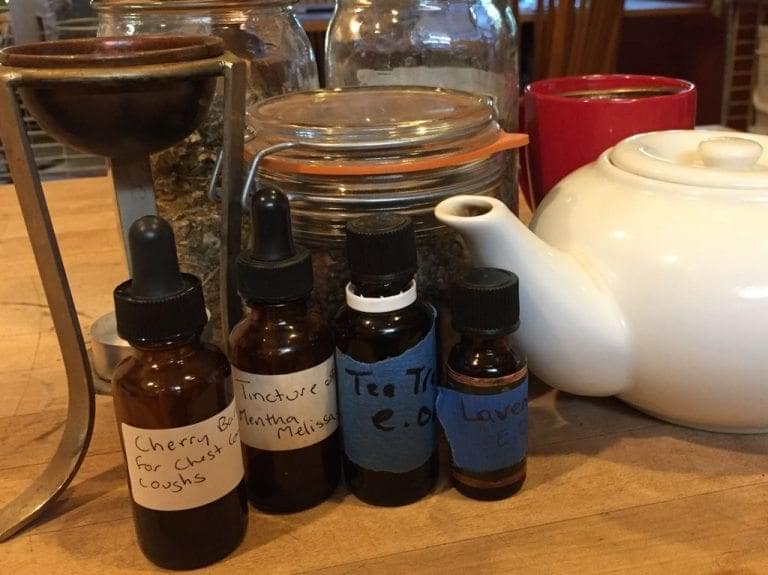According to the US Center for Disease Control (CDC), flu and cold season typically covers October through May with its peak somewhere in December to February. In the Pacific Northwest, the rainy season’s damp and chilly weather provides the right conditions for viruses to thrive; for us, with the rain comes the flu and cold season.
This year, we’re facing a more virulent strain of coronavirus, which is spreading in pandemic fashion. Some experts are suggesting that everyone is going to come into contact with this one, no matter how we isolate ourselves. Whether that’s true or not, it makes a whole lot of sense to adopt the Herbalist’s approach by strengthening your immune system, adopting good hygiene practices, and making extra space for prevention of all potential illness.
Cold and Flu Prevention: The Best Solution
Lifestyle and Environmental habits can make a huge difference in how often you get sick and how long you stay sick. Basic Strategies for staying healthy include:
- Eat a balanced, healthy diet, high in vegetables, low in dairy, carbohydrates, and meats.
- Get plenty of rest.
- De-stress and exercise regularly.
- Practice good hygiene for yourself and your environment (Eucalyptus, Lavender, Tea Tree)
Add herbs that offer nutrition and immune-boosting energies to your diet, such as:
- Nettle — High in Vitamins A, B, C; and essential minerals, calcium, iron, magnesium, potassium; Also contains beta-carotene, tannins, and a host of other nutrients. Pairs well with Raspberry Leaf. Nutritive, anti-histamine, mild laxative. Generally safe including during pregnancy and nursing, but can interact with some prescription drugs. (See “Nettle: Nutritious Allergy Ally,” https://thepracticalherbalist.com/holistic-medicine-library/nettle-nutritious-allergy-ally/)
- Alfalfa–High in nutrition: Protein, calcium, copper, iron, magnesium, phosphorus, potassium, zinc, Vitamins K, A, B1, B6, B12, C, D, E, biotin, folic acid, niacin, pantothenic acid, amino acids, beta-carotene, chlorophyll, flavonoids, saponins, and sterols. Generally safe, including for pregnancy and nursing. Nutritive. (see “Healthy Uses for Alfalfa Herb” on WellnessMama, http://wellnessmama.com/188/alfalfa-herb-profile/)
- Raspberry Leaf–High in Vitamin C and folate, calcium, iron, zinc. Anti-inflammatory,Astringent and Nutritive, generally healing to the lower digestive tract. Generally safe, including for pregnancy and nursing. (see “Raspberry: The Female Toner,” https://thepracticalherbalist.com/holistic-medicine-library/raspberry-the-female-toner/)
- Red Clover–High in bioflavonoids and isoflavones and generally nutritious. Blood-fortifier and cleanser that builds the system gently. Generally safe, but avoid during pregnancy. (see “How to Use Red Clover Herbs,” Wellness Mama.com, http://wellnessmama.com/37/red-clover/)
- Astragalus–Builds the immune system with time. Use daily, year-round or through the whole of the flu and cold season. Adaptogenetic, anti-inflammatory, anti-bacterial. Generally safe, but can interact with some prescription drugs. (See U of Maryland Medical Center, “Astragalus,” https://umm.edu/health/medical/altmed/herb/astragalus)
- Echinacea–Triggers the immune system into action by encouraging the building of extra white blood cells. Use for up to 14 days at a time, then rest for at least 14 days before taking it again. Generally safe for all ages. Avoid if you’re allergic to ragweed. (see U of Maryland’s “Echinacea,” https://umm.edu/health/medical/altmed/herb/echinacea)
- Elderberry–Helps strengthen cell walls, making it harder for viruses to with the battle. Nutritive, Anti-inflammatory, Anti-viral. Safe for daily use. See (“Elderberry: The Flu Fighter,” https://thepracticalherbalist.com/holistic-medicine-library/elderberry-the-flu-fighter/)
Others for general health and illness prevention include the Garlic and Onion family, Horseradish, Cayenne and Chili peppers, Thyme and the other Mediterraneans.
When Illness Happens: Ease the Symptoms
Even with the best prevention strategies, illness happens. Use these strategies to ease symptoms, prevent it from getting worse, and shorten the duration of illness:
- Get rest (Valerian, Passion Flower, Hops, Oats)
- Create a healthy atmosphere with aromatherapy (Eucalyptus, Thyme, Tea Tree, Lemon Balm)
Use herbs and foods to ease symptoms:
- Digestion (Apple, Pear, Plum, Banana, Ginger)
- Fever (Elder flower, Yarrow, Linden)
- Sinus Congestion and Runny Sinuses (Elder Flower, Calendula, Black Tea, Yarrow, Lavender, Sage, Thyme; Eucalyptus and Tea Tree aromatherapy)
- Sore Throat (Elecampane, Slippery Elm, Marshmallow, Clove Gargle, Sage)
- Coughing (Elecampane, Coltsfoot, Cherry Bark, Marshmallow)
- Lung or Chest congestion (Elecampane, Usnea, Licorice Root, Yarrow, Thyme, Black Tea, Calendula, Sage, Chili Pepper topically; Eucalyptus, Tea Tree topically or through aromatherapy)
- Whole system (Oregon Grape Root, Thyme, Cayenne or Chili Pepper, Licorice Root)
Recovery: Rebuild and Prevent Secondary Illnesses
Once symptoms begin to ease, it’s tempting to jump back into regular life. Don’t. Instead, give your body time and support in rebuilding your health. The best way to prevent relapses or secondary illnesses is through rest and healthful nutrition. Try these strategies:
- Make time and space for proper sleep.
- Ask for help in catching up on tasks that slid while you were ill.
- Ease back into life, and support your system with foods and herbs that support good health, including all of the prevention herbs plus gentle detox herbs like Dandelion, Burdock, Cleavers, Red Clover, and Licorice Root.
Daily Illness Prevention Recipe: Fire Cider Tonic Vinegar
Fire Cider tonics are an excellent, easy way to build daily illness prevention into your life. Try a classic recipe, such as Rosemary Gladstar’s Fire Cider, or a Pacific Northwestern take on the Fire Cider mix such as Sue Sierralupé’s Salamander Fire Cider Recipe on The Practical Herbalist. Take a tablespoon or two daily directly or watered down, or incorporate a couple of tablespoons into your daily diet. These tonic vinegars make a lovely salad dressing or flavoring for greens or other cooked or roasted vegetables. They’re also dynamite at helping your body create the kind of environment that’s less hospitable to viruses and bacteria, making them a good medicine when you’re ill as well.
Further Resources:
The University of Maryland Medical Center, Complementary and Alternative Medicine Guide
Backyard Medicine: Harvest and Make Your Own Herbal Remedies by Julie Brunton-Seal and Matthew Seal
Aromatherapy: A Complete Guide to the Healing Art, second edition by Kathi Keville and Mindy Green
Herbal Medicine From the Heart of the Earth by Sharol Tilgner (for a modern, scientific approach)
The Book of Herbal Wisdom: Using Plants as Medicines by Matthew Wood (for a approach grounded in Native and Ancient herbal wisdom with an energetic approach)
The Holistic Herbalist show 116: Herbs for Coronavirus Preparedness
Holistic Herbal Therapeutics and Influenza by Sajah Popham
Notes
Candace Hunter
Candace Hunter is author of Herbalism for the Zombie Apocalypse and co-author of The Practical Herbalist Herbal Folios Series. She edits The Practical Herbalist website and Practical Herbalist Press publications. She co-hosts Real Herbalism Radio, a bi-weekly podcast on herbs, homesteading, and the herbalist lifestyle. For more information, find her online at CandaceHunter.com.






